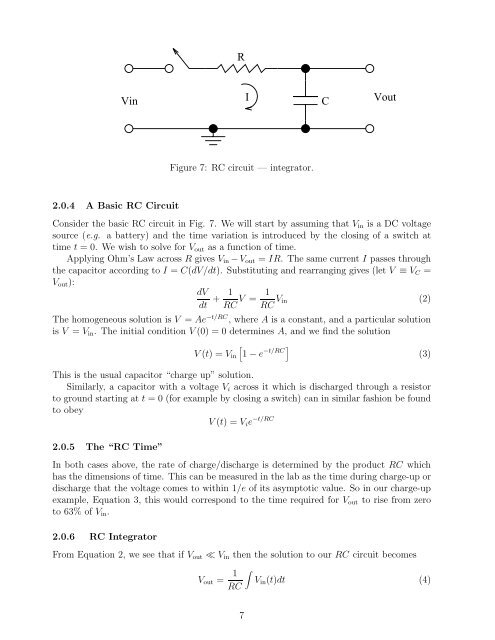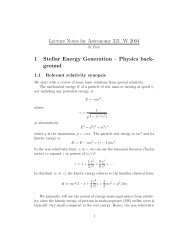Lecture Notes for Analog Electronics - The Electronic Universe ...
Lecture Notes for Analog Electronics - The Electronic Universe ...
Lecture Notes for Analog Electronics - The Electronic Universe ...
You also want an ePaper? Increase the reach of your titles
YUMPU automatically turns print PDFs into web optimized ePapers that Google loves.
Vin<br />
2.0.4 A Basic RC Circuit<br />
R<br />
Figure 7: RC circuit — integrator.<br />
I<br />
C<br />
Vout<br />
Consider the basic RC circuit in Fig. 7. We will start by assuming that Vin is a DC voltage<br />
source (e.g. a battery) and the time variation is introduced by the closing of a switch at<br />
time t = 0. We wish to solve <strong>for</strong> Vout as a function of time.<br />
Applying Ohm’s Law across R gives Vin − Vout = IR. <strong>The</strong> same current I passes through<br />
the capacitor according to I = C(dV/dt). Substituting and rearranging gives (let V ≡ VC =<br />
Vout):<br />
dV<br />
dt<br />
1 1<br />
+ V =<br />
RC RC Vin<br />
<strong>The</strong> homogeneous solution is V = Ae −t/RC ,whereAis a constant, and a particular solution<br />
is V = Vin. <strong>The</strong> initial condition V (0) = 0 determines A, and we find the solution<br />
V (t) =Vin<br />
�<br />
�<br />
−t/RC<br />
1 − e<br />
This is the usual capacitor “charge up” solution.<br />
Similarly, a capacitor with a voltage Vi across it which is discharged through a resistor<br />
to ground starting at t = 0 (<strong>for</strong> example by closing a switch) can in similar fashion be found<br />
to obey<br />
V (t) =Vie −t/RC<br />
2.0.5 <strong>The</strong> “RC Time”<br />
In both cases above, the rate of charge/discharge is determined by the product RC which<br />
has the dimensions of time. This can be measured in the lab as the time during charge-up or<br />
discharge that the voltage comes to within 1/e of its asymptotic value. So in our charge-up<br />
example, Equation 3, this would correspond to the time required <strong>for</strong> Vout to rise from zero<br />
to 63% of Vin.<br />
2.0.6 RC Integrator<br />
From Equation 2, we see that if Vout ≪ Vin then the solution to our RC circuit becomes<br />
Vout = 1<br />
�<br />
RC<br />
Vin(t)dt (4)<br />
7<br />
(2)<br />
(3)













